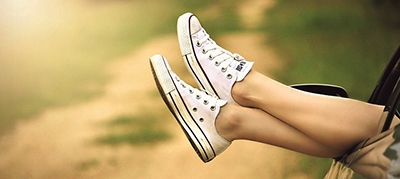The Foot
A biological masterpiece
| Download this episode | It’s summer and everywhere you look, people are wearing sandals and flip flops. The human foot is something of a biological masterpiece, capable of withstanding incredible stress. According to an American Podiatric Medical Association study, a 150-pound person walking just one mile exerts a force of 63.5 tons on a single foot. As small as it may be, the human foot contains a total of 26 bones, 33 joints and a network of more than 100 tendons, muscles, and ligaments, to say nothing of blood vessels and nerves. Foot ailments are among the most common of our health problems. Although some can be traced to heredity, many stem from the cumulative impact of a lifetime of abuse and neglect. Studies show that most Americans experience foot problems like bunions, hammertoes or heel pain at some point in their lives and few seek medical treatment, apparently because they mistakenly believe that discomfort is normal and expectable. | Osteoporosis is a disease of progressive bone loss associated with an increased risk of fractures. The disease often develops unnoticed over many years, with no symptoms or discomfort, until a fracture occurs. A stress fracture in the foot is often the first sign. One thing you can do to prevent osteoporosis, slow its progression and protect yourself from fractures is include adequate amounts of calcium and vitamin D in your diet. Although calcium can’t prevent gradual bone loss after menopause, it continues to play a role in maintaining bone quality. How much calcium you need will vary depending on your age so talk to your doctor before taking a calcium supplement. Vitamin D helps your body absorb calcium. The recommendation for vitamin D is 400 to 1,000 international units daily. Vitamin supplements can be taken if your diet doesn’t contain enough of this nutrient but consult with your doctor as too much vitamin D can be toxic. | Athlete’s foot is a skin disease caused by a fungus, usually occurring between the toes. The fungus most commonly attacks the feet because shoes create a warm, dark, and humid environment which encourages fungus growth. The warmth and dampness of areas around swimming pools, showers, and locker rooms are also breeding grounds for fungi. The signs of athlete’s foot, singly or combined, are dry skin, itching, scaling, inflammation, and blisters. If your athlete’s foot is severe or doesn’t respond to over-the-counter medicine, you may need a prescription-strength topical medication, lotion, spray or ointment, or an oral medication. To help avoid athlete’s foot or ease its symptoms, wear socks that are made of natural material like cotton or wool or a synthetic fiber designed to draw moisture away from your feet, change your socks and stockings regularly, and go barefoot to let your feet air out as much as possible when you’re home. | A bunion, clinically known as hallux valgus, is a prominent bump of the great toe at the outer edge where it joins the foot. This bump is sensitive to pressure caused from wearing shoes that fit too tightly. Shoes that are pointed and too narrow squeeze the great toe causing it to drift toward the little toes. When a bunion first begins to develop, take good care of your feet and wear wide-toed shoes. This can often solve the problem and prevent the need for any further treatment. It may help to wear felt or foam pads on the foot to protect the bunion, or devices called spacers to separate the first and second toes at night. These are available at drugstores. You can also try cutting a hole in a pair of old shoes to wear around the house. If the bunion gets worse, resulting in severe pain, surgery to realign the toe and remove the bony bump may be required. There are over 100 different surgical techniques that have been described to treat this condition. | An infection of the toenail is called onychomycosis. The nail may look brownish, yellowish or have little white patches. The nail may get flaky, ragged and chipped. In some cases, the toenail may get so thick that wearing shoes can cause pain. Infected nails may also separate from the nail bed, a condition called onycholysis. Unfortunately, over-the-counter creams and ointments generally do not help treat this condition. Prescription antifungal medicines taken by mouth may help clear the fungus in about 50 percent of patients. However, such medicines can cause side effects or may interfere with other medications. Some of the oral medications used to treat fungal infections of the nail can harm the liver. In some cases, the health care provider may remove the nail. Toenails grow slowly and even if treatment is successful, a new, clearer nail may take up to a year to grow in. And even with successful treatment, it is common for the fungus to return.
Transcript
Osteoporosis
Transcript
Athlete’s foot
Transcript
Bunions
Transcript
Toenail infections
Transcript
